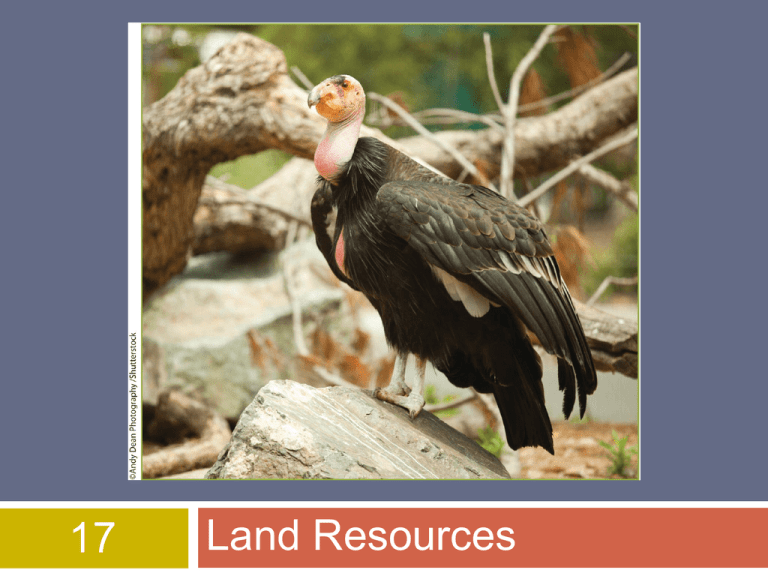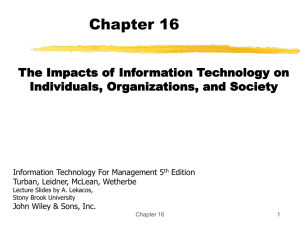
17
Land Resources
Overview of Chapter 17
Land Use
Wilderness, Parks, and Wildlife Refuges
Forests
Rangeland and Agricultural Lands
Wetlands and Coastal Areas
Conservation of Land Resources
© 2015 John Wiley & Sons, Inc. All rights reserved.
Pinnacles National Park
2013 added to National Parks
Total
of 59 in U.S.
Native California condors observed
Parks preserve land as
much as possible
For
enjoyment and use by
future generations
Can take decades to
establish
© 2015 John Wiley & Sons, Inc. All rights reserved.
Land Use- Worldwide
© 2015 John Wiley & Sons, Inc. All rights reserved.
Land Use - United States
© 2015 John Wiley & Sons, Inc. All rights reserved.
Land Use - United States
55% of US land is privately owned
Remainder of land is owned by government
© 2015 John Wiley & Sons, Inc. All rights reserved.
Managing Public and Private Land
Public Planning and Land Use
Land
use decisions are complex with multiple
effects
Must take into account
All
repercussions of proposed land use
Ecosystem services of undeveloped land
© 2015 John Wiley & Sons, Inc. All rights reserved.
Wilderness Parks and Wildlife
Refuges
Wilderness
A
protected area of land in which no human
development is permitted
Wilderness Act (1964)
Set
aside federally
owned land
Managed by NPS,
USFS, FWS,
&BLM
© 2015 John Wiley & Sons, Inc. All rights reserved.
National Park System
Created in 1916
Currently includes 58
parks
Primary goal
Yosemite National Park
Teach
people about the
natural environment,
management of natural
resources and history
of a site
© 2015 John Wiley & Sons, Inc. All rights reserved.
National Park System
Threats to U.S. Parks
Crime
& Vandalism
Traffic jams
Pollution of the soil, water and air
Resource violations
Natural Regulation
Policy
to let nature take its course
No culling wildlife or suppressing wildfire
© 2015 John Wiley & Sons, Inc. All rights reserved.
Wildlife Refuges
National Wildlife Refuge System
Established
1903 by Theodore Roosevelt
Most extensive network of lands and waters
committed to wildlife habitat in the world
560 refuges nationwide
Represent all major ecosystems found in U.S.
Mission
To
preserve lands and waters for the conservation
of fishes, wildlife, and plants of the US
© 2015 John Wiley & Sons, Inc. All rights reserved.
Forests
Role in Hydrologic
Cycle (right)
Forest Management
Deforestation
Forest Trends in the
U.S.
Trends in Tropical
Forests
Boreal Forests
© 2015 John Wiley & Sons, Inc. All rights reserved.
Forest Management
Traditional Forest
Management
Low
diversitymonocultures
One
type of plant is
cultivated over a large
area
Managed
for timber
production
© 2015 John Wiley & Sons, Inc. All rights reserved.
Forest Management
Ecological Sustainable Forest Management
Environmentally
balanced
Diverse
trees
Prevent soil erosion
Preserve watersheds
Wildlife corridors- unlogged
Unlogged areas set aside as habitat corridors
Short and long-term health is managed
© 2015 John Wiley & Sons, Inc. All rights reserved.
Harvesting Trees
© 2015 John Wiley & Sons, Inc. All rights reserved.
Deforestation
Temporary or permanent clearance of large
expanses of forest for agriculture or other use
World forests shrank 32 million acres annually
from 2000–2010
Causes
Fire
Expansion
of agriculture
Construction of roads
Tree harvest
Insect and disease
© 2015 John Wiley & Sons, Inc. All rights reserved.
Deforestation
Results of Deforestation
Decreased
soil fertility
Uncontrolled soil erosion
Production of hydroelectric power (silt build up
behind dams)
Increased sedimentation of waterways
Formation of deserts
Extinction of species
Global climate changes
© 2015 John Wiley & Sons, Inc. All rights reserved.
Forest Trends in U.S.
Most temperature
forest are steady or
expanding
Returning stands lack
biodiversity of original
forests
More than half of U.S.
forest are privately
owned (right)
Forest Legacy Program
Conservation easement
© 2015 John Wiley & Sons, Inc. All rights reserved.
U.S. National Forests
Managed for multiple uses
Timber
harvest
Livestock forage
Water resource and watershed protection
Mining, hunting, fishing, etc.
Road building is an issue
Provides
logging companies with access to forest
Clear cutting is an issue
© 2015 John Wiley & Sons, Inc. All rights reserved.
Case-In-Point Tongass National Park
One of world’s few temperate rainforests
Prime logging area
Modified 1997 Forest Plan
Roadless Area
Conservation Rule
(2000)
Politics rules
government
agencies
© 2015 John Wiley & Sons, Inc. All rights reserved.
Trends in Tropical Forests
Tropical rainforests (below) and tropical dry
forests
© 2015 John Wiley & Sons, Inc. All rights reserved.
Disappearing Tropical Rain Forests
Immediate causes
Subsistence
agriculture
Commercial logging
Cattle ranching
Other causes
Mining
Hydroelectric
power
Human Settlement in a
Brazilian Tropical Rain Forest
© 2015 John Wiley & Sons, Inc. All rights reserved.
Disappearing Tropical Dry Forests
Primarily destroyed for fuel wood
Used
for heating and cooking
Led to fuel crisis in many countries
Increase
in waterborne diseases (cooking water
is not boiled)
© 2015 John Wiley & Sons, Inc. All rights reserved.
Boreal Forests
World’s largest
biome
Extensive clear
cutting
Primary
source of
world’s industrial
wood and wood
fiber
© 2015 John Wiley & Sons, Inc. All rights reserved.
Rangeland and Agricultural lands
Rangeland
Land
that is not intensively managed and is used
for grazing livestock
© 2015 John Wiley & Sons, Inc. All rights reserved.
Rangeland Degradation and
Deforestation
Overgrazing leaves ground barren
Animals
exceed land’s carrying capacity
Land degradation
Natural
or human-induced process that
decreases future ability of land to support crops
or livestock
Desertification
Degradation
of once fertile land into
nonproductive desert
© 2015 John Wiley & Sons, Inc. All rights reserved.
Rangeland Trends in U.S.
Make up 30% of total U.S. land area
Pressure from developers to subdivide
Public rangeland managed by:
Taylor
Grazing Act (1934)
Federal Land Policy and Management Act (1976)
Conditions of public rangeland are slowly
improving
© 2015 John Wiley & Sons, Inc. All rights reserved.
Agricultural Land
U.S. has 300 million acres of prime farmland
Suburban sprawl
Parking
lots
Housing
developments
Shopping malls
© 2015 John Wiley & Sons, Inc. All rights reserved.
Wetlands
Lands that are usually covered with water for
at least part of the year
Have characteristic soils, and water-tolerant
vegetation
Benefits
Habitat
for migratory waterfowl and wildlife
Recharge groundwater
Reduce damage from flooding
Improve water quality
Produce many commercially important products
© 2015 John Wiley & Sons, Inc. All rights reserved.
Human Threats to Wetlands
Drainage for agriculture or mosquito control
Dredging for navigation
Construction of dams, dykes or seawalls
Filling in for solid waste disposal
Road building
Mining for gravel, fossil fuels, etc.
Shrinking 24,300 acres per year since 1985
© 2015 John Wiley & Sons, Inc. All rights reserved.
Protection of Wetlands
Clean Water Act (1972)
No
clear definition of wetland
Emergency Wetlands Resource Act (1986)
Corp of Engineers
Manuals
Opponents of wetland
protection find it
infringes on use of
privately-owned land
© 2015 John Wiley & Sons, Inc. All rights reserved.
Coastlines
Coastal wetlands
Provide
food and habitat for many aquatic
animals
Historically regarded as wasteland
U.S. starting to see
importance of
protecting this
environment
Retaining
seawalls
(right)
© 2015 John Wiley & Sons, Inc. All rights reserved.
Coastal Demographics
Many coastal areas overdeveloped
3.8
billion people live within 150km of coastline
6.0 billion people will likely live there by 2025
United States
14
of 20 largest U.S. cities along coast
19 of 20 most densely populated countries along
coasts
© 2015 John Wiley & Sons, Inc. All rights reserved.
Conservation and Land Resources
Four criteria of importance of conservation:
Areas
lost or degraded since European
colonization
Number of present examples of a particular
ecosystem (or the total area)
Estimate of the likelihood that a given ecosystem
will lose significant area or be degraded in next
10 years
Number of threatened and endangered species
living in the ecosystem
© 2015 John Wiley & Sons, Inc. All rights reserved.
Conservation and Land Resources
© 2015 John Wiley & Sons, Inc. All rights reserved.
Conservation and Land Resources
© 2015 John Wiley & Sons, Inc. All rights reserved.




